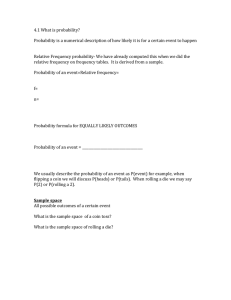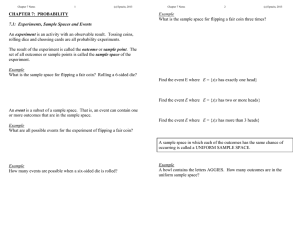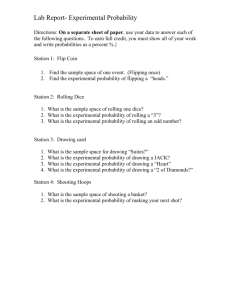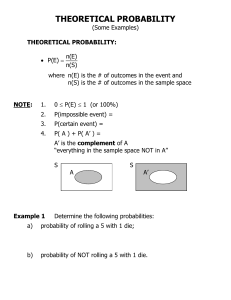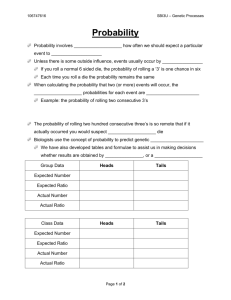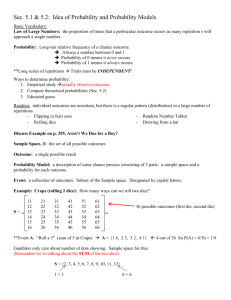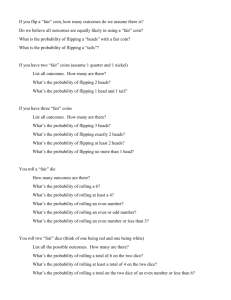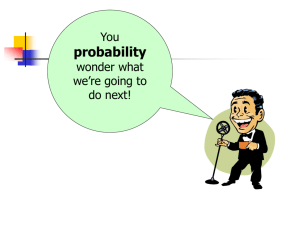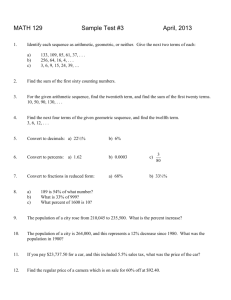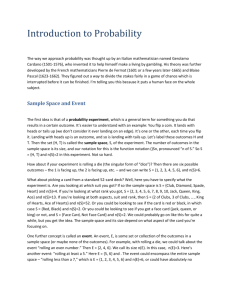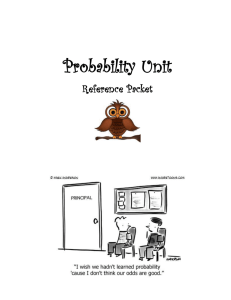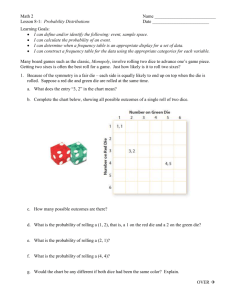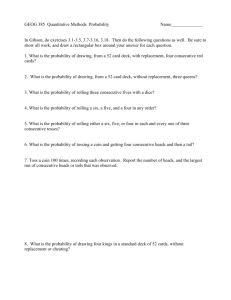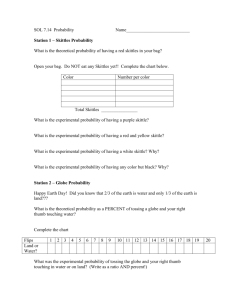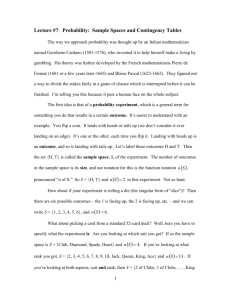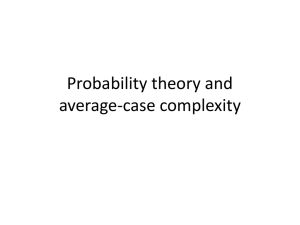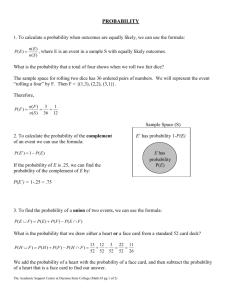Sec. 6.1 and 6.2 Part 1 Blank Notes
advertisement
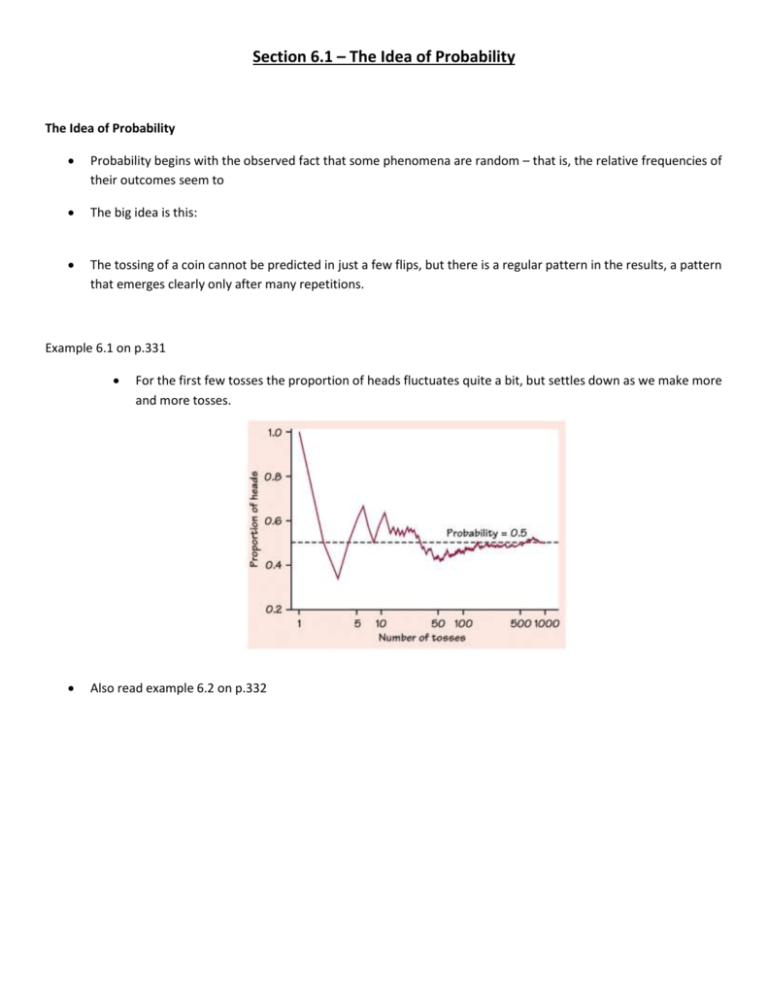
Section 6.1 – The Idea of Probability
The Idea of Probability
Probability begins with the observed fact that some phenomena are random – that is, the relative frequencies of
their outcomes seem to settle down to fixed values in the long run.
The big idea is this: chance behavior is unpredictable in the short run but has a regular and predictable pattern
in the long run.
The tossing of a coin cannot be predicted in just a few flips, but there is a regular pattern in the results, a pattern
that emerges clearly only after many repetitions.
Example 6.1 on p.331
For the first few tosses the proportion of heads fluctuates quite a bit, but settles down as we make more
and more tosses.
Also read example 6.2 on p.332
Section 6.2 Part 1 – Probability Models
Basic Descriptions of Probability Models:
A probability model is a mathematical description of a random phenomenon consisting of two parts:
A set of all possible outcomes, the sample space S.
A way of assigning probabilities to events.
A sample space can be very simple (such as rolling a single die) or very complex (rolling 100 dice).
An event is any outcome or a set of outcomes of a random phenomenon.
An event is essentially a ________________ of a sample space.
Example:
Consider tossing two fair coins:
The sample space (or list of all outcomes) would be S = {HH, HT, TH, TT}
Examples of events could include: P(0 heads), P(1 head), P(2 heads), or P(HT)
The probabilities for each event are based on the fact that there are four possible outcomes
Example 6.3 – Rolling Two Dice
Rolling two dice will have a total of 36 outcomes:
If you were to roll the two dice and record the up-faces in order (first die, second die) you would have a sample
space consisting of all 36 outcomes shown above.
If you were to change the scenario to only caring about the number of pips on the up-faces of the dice then the
sample space would be:
S = {2, 3, 4, 5, 6, 7, 8, 9, 10, 11, 12}
“Rolling a sum of 5” is considered an event, which can occur multiple ways:
P(sum 5) = 4/36 or 1/9
Example 6.5 – Flip a Coin and Roll a Die
An experiment consists of flipping a coin and rolling a die. Find the sample space.
Use a tree diagram to represent the possible outcomes:
Multiplication Principle
If you can do one task in a number of ways and a second task in b number of ways, then both tasks can be done
in a x b number of ways.
Example:
We already found that there are 12 outcomes when flipping a coin and rolling a die. To
determine the number of outcomes without the tree diagram take the number of outcomes for
flipping a coin (2) and multiply it by the number of outcomes for rolling a die (6).
Example 6.6 – Flip Four Coins
Flipping four coins. What is the size of the sample space? List all possibilities.
The total number of outcomes (or size of the sample space) can be represented by 2 × 2 × 2 × 2 or 24
giving a total of 16 outcomes.
The list can be organized in different ways:
Suppose our only interest in the last example is the number of heads we get in four tosses. What is the sample
space?
S = {0, 1, 2, 3, 4}
Probability models can also be used to determine possible outcomes for other situations.
For example, the possible outcomes of an SRS of 1500 people are the same as
___________________________________________ when a question is answered “yes” or “no”.
Some sample spaces are simply too large to be able to list all possible outcomes in which case computer
programs are used.
Additional Definitions
With replacement refers to the drawing of an object, recording the selection and then putting it back so that it
may be drawn again.
Example:
How many 3 digit numbers can you make?
10 × 10 × 10 = 1000
This is assuming that each digit is eligible for each of the 3 positions
Without replacement refers to the drawing of an object, recording the selection and then not putting it back so
it can’t be drawn again.
Example:
How many 3 digit numbers can be written if the numbers cannot be repeated?
10 × 9 × 8 = 720
